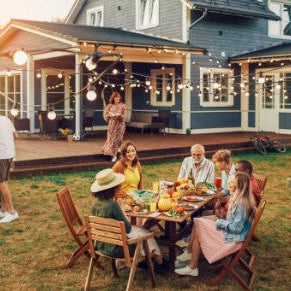

A Longevity Lifestyle
Eating for Longevity
What do Loma Linda, Ikaria, Okinawa, Nicoya, and Sardinia have in common? These are the five Blue Zones – places in the US, Greece, Japan, Costa Rica, and Italy, respectively, that are home to some of the oldest and healthiest people alive today. Average life expectancy is far higher in these Blue Zones, and people tend to stay healthier for longer. Indeed, researcher Dan Buettner and colleagues at National Geographic identified these five Blue Zones in 2004 as places where people reached 100 at 10 times the rate for the rest of the US.[1] So, what’s their secret? What makes these places different, and what can we learn from some of the healthiest, longest-living people on the planet? By comparing the diet and lifestyle of people living the longest in these Blue Zones, researchers figured out eight things that these people have in common. Happily, many of these are things we can put into immediate effect wherever we live.
1. Eat mostly plants
One of the main findings from the Blue Zone research is that those who enjoy greater longevity and long-lasting health eat a predominantly plant-based diet. That’s right, a diet consisting mostly of vegetables, fruits, nuts, seeds, legumes, and grains offers a wide range of nutrients that can help keep the aging process at bay for a little longer. Most Blue Zone residents consumed an array of fresh fruits and vegetables, with a high intake of beans, especially fava, soy, black beans, and lentils. They also regularly ate nuts, a handful or so a day, which are a great source of many minerals, healthy fats, fibre, protein, vitamins, and other phytonutrients. Dan Buettner and colleagues found that the typical diet for those living in Blue Zones included 90-100% plant-based foods. Some Blue Zoners ate meat on occasion, but this was treated more like a celebratory condiment rather than the main event of a meal. In addition to the health benefits of plant-based foods, a diet that keeps animal products to a minimum and favours locally grown organic food also has a much lower environmental footprint. This has indirect health benefits by reducing risks of wildfires and other effects of climate change, and by helping to keep air and water cleaner and healthier. What about the other eight takeaways from the Blue Zones? In brief, these comprise of:
2. Moving naturally
There’s no need for gym memberships for Blue Zone residents. Instead, these folks incorporate natural movement into their regular day, such as walking to the store or friends’ houses, using the stairs, gardening, hanging out laundry, doing other housework, and playing with grandkids. Time-saving gadgets and gizmos are all well and good, as are elevators and escalators, but unless you need to use these for mobility or health concerns, try making your life a little less convenient. That way, you can simplify and build natural exercise into your day for free!
3. Have a sense of purpose
This one’s a little trickier, but Blue Zone residents are more likely than the average global citizen to know their purpose. For Okinawans, this is called ikigai. For Nicoyans, plan de vida. Basically, having a reason to get up in the morning, something that calls you to action, can add years to your life. If you’re feeling a little lost (understandable in these strange times), consider your skills, talents, passions, and creative urges. Are there problems in your community that you desperately want to help fix? Are there things about your life that you want to change and are in your power to change? Finding a sense of purpose can take a little digging and hard self-examination, but if it adds years to your life, you can probably spare a half hour or so now to jot down some thoughts.
4. Take a nap (downshift)
OK, so taking a nap is just part of it, but downshifting and avoiding an overcomplicated schedule is a big part of life in the Blue Zone. Whether it’s through daily mindfulness practice, stretching and relaxation, afternoon happy hour, regular journaling, or just settling in with a good book, folks in Okinawa, Ikaria, Sardinia, and other Blue Zones have figured out effective stress-busting strategies that can keep you from feeling blue but definitely put you in the zone.
5. The 80% rule
At its core, the 80% rule is a way of cutting back on dietary excesses. Okinawans stop eating when they feel 80% full, for instance, rather than gorging until they burst. Blue Zone residents also eat most of their calories early in the day, with a big breakfast, moderate lunch, and a small, early dinner, with no snacking after. This dietary pattern might sound familiar if you’ve dabbled in intermittent fasting. Indeed, many Blue Zones have a dietary pattern that looks a lot like a 16:8 fast. You can also adopt the 80% rule by replacing large plates and glassware with 20% smaller versions.
6. Build and enjoy community
The longest living and happiest people in the world are those born into or who create communities that support healthy habits for life. This means a tight-knit circle of family, chosen or otherwise, and friends who get together regularly and aren’t tied together by unhealthy behaviours like smoking, drinking to excess, eating charred barbecued meat, or doing solely sedentary things. Okinawans, for example, create “moai,” groups of five friends who commit to each other for life. So, think about your friend group and family and see if there are already folks who can become your new running partner, someone to encourage a daily healthy smoothie habit, or just a group of five to share a glass of red wine at 5 pm.
7. Belong
Almost every centenarian interviewed in the original Blue Zone research belonged to some kind of community-based group with strong relationships beyond immediate family and friends. This could be a civic organization or other close-knit group, such as a hobby-based group. You’re already doing the work with your ‘moai’, so extend it out by bringing others into the fold on a regular basis or joining an existing community group.
8. Family first
The Blue Zone centenarians were also notable in that they put their families first, meaning that many lived in multigenerational households. It’s no surprise that parents and grandparents encouraged to age-in-place tend to stay more engaged and active, healthy and happy, compared to older adults who are more isolated from family and friends. Family first can also mean investing time and care in long-term, close partnerships, housemates, community ties, and children.
Final Thoughts from the Blue Zone
If carbs have been your enemy for a while, take heart that in the Blue Zone carbs are back on the table, literally. People living in Blue Zones consume about 65% of calories from carbohydrates, almost always from foods that are high in fibre and a wealth of nutrients. Buettner highlights beans in particular, as the “carb of choice” for centenarians. Other good carb sources include grains, greens, tubers, nuts, and seeds. Basically, no processed carbohydrates that have had their fibre, vitamins, minerals, and other nutrients removed. Meat is also a feature in many Blue Zones, but as a celebratory food, not a staple with every meal. Meat is typically eaten just five or so times a month and in small amounts. As with wine, there’s no need to start eating meat if you don’t already. But, if you currently eat a lot of animal-derived foods, the research out of these Blue Zones strongly suggests focusing on plant-based proteins instead. And finally, in addition to that glass of wine at 5 pm, consider keeping your other beverage choices to a cup of coffee in the morning and six glasses of water a day. No sugary sodas or other beverages with “hidden” calories. And, of course, when you raise a glass, raise a toast to a long and healthy life!
References: (1) Dan Buettner. (2016). Power 9®, Reverse Engineering Longevity. Available from: https://www.bluezones.com/2016/11/power-9/
Article from: Raw Whole Food Supplements from Whole Earth & Sea (wholeearthsea.com)



